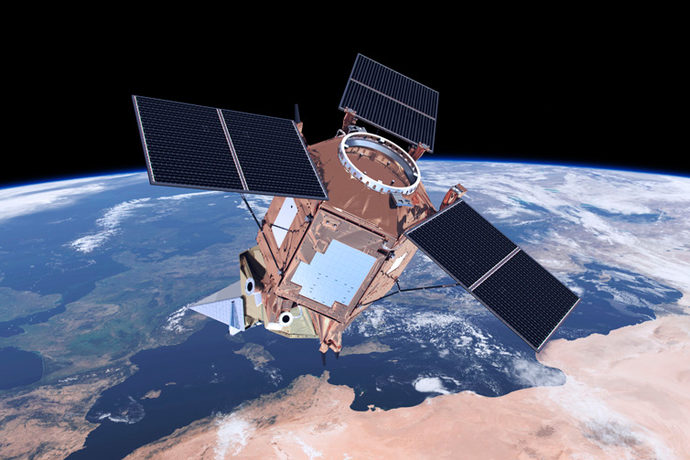Global S&T Development Trend Analysis Platform of Resources and Environment
| Newly launched Sentinel-5P satellite to monitor the atmosphere | |
| admin | |
| 2017-10-13 | |
| 发布年 | 2017 |
| 语种 | 英语 |
| 国家 | 欧洲 |
| 领域 | 地球科学 ; 气候变化 |
| 正文(英文) | 
Artist’s impression of Sentinel-5P in orbit. The satellite is the first Copernicus mission dedicated to monitoring the composition of the atmosphere. (Image: ESA/ATG medialab) The Sentinel-5P satellite launched on 13 October 2017 will make a vital contribution to the ECMWF-run Copernicus Atmosphere Monitoring Service (CAMS) by measuring the composition of the atmosphere. The polar-orbiting satellite was launched from the Plesetsk Cosmodrome in northern Russia. It is part of a fleet of Sentinels supporting the European Union’s Copernicus Earth observation programme. Sentinel-5P carries the state-of-the-art Tropomi instrument to map trace gases such as nitrogen dioxide, ozone, formaldehyde, sulphur dioxide, methane, carbon monoxide and aerosols. “The satellite will in particular provide daily coverage of nitrogen dioxide (NO2), a key pollutant, with a much finer spatial resolution than was previously available,” says Head of CAMS Vincent-Henri Peuch. “It will be able to see urban sources much more precisely. This is essential. Sentinel-5P will detect sources that are not accounted for in air quality forecast models or that are not well quantified.” The satellite was developed by ESA while the Tropomi advanced spectrometer was provided by the Netherlands.
The Sentinel-5P satellite was encapsulated within the launcher fairing 10 days ahead of its launch from the Plesetsk Cosmodrome in northern Russia. (Photo: ESA–Stephane Corvaja, 2017) Reducing data gapsSentinel-5P will reduce data gaps between ESA’s Envisat satellite mission, which ended in 2012, and the Sentinel-5 mission from around 2021. It will complement the GOME-2 spectrometer on EUMETSAT’s MetOp satellites. With a swath width of 2600 km, the satellite will map the entire planet every day. In addition to supporting air quality forecasts and decision-making, the mission will contribute to services such as volcanic ash monitoring and UV radiation warnings. Scientists will also use the data to study processes in the atmosphere related to climate and the formation of holes in the ozone layer. In the future, both the geostationary Sentinel-4 and polar-orbiting Sentinel-5 missions will monitor the composition of the atmosphere for CAMS. Both missions will be carried on meteorological satellites operated by EUMETSAT. “Since 1979, the ozone layer has been continually monitored from space. Today Sentinel-5P is taking over this essential function until Sentinel-4 and Sentinel-5 are put into orbit 5 or 6 years from now,” says Richard Engelen, Deputy Head of CAMS. “This is vital information for forecasting UV radiation and for continuing to monitor the progressive recovery of the ozone layer.”
The satellite was taken into orbit on a Rockot launcher from the Plesetsk Cosmodrome in northern Russia. (Screenshot from ESA livestream) |
| URL | 查看原文 |
| 来源平台 | European Centre for Medium-Range Weather Forecasts |
| 文献类型 | 新闻 |
| 条目标识符 | http://119.78.100.173/C666/handle/2XK7JSWQ/103357 |
| 专题 | 地球科学 气候变化 |
| 推荐引用方式 GB/T 7714 | admin. Newly launched Sentinel-5P satellite to monitor the atmosphere. 2017. |
| 条目包含的文件 | 条目无相关文件。 | |||||
| 个性服务 |
| 推荐该条目 |
| 保存到收藏夹 |
| 查看访问统计 |
| 导出为Endnote文件 |
| 谷歌学术 |
| 谷歌学术中相似的文章 |
| [admin]的文章 |
| 百度学术 |
| 百度学术中相似的文章 |
| [admin]的文章 |
| 必应学术 |
| 必应学术中相似的文章 |
| [admin]的文章 |
| 相关权益政策 |
| 暂无数据 |
| 收藏/分享 |
除非特别说明,本系统中所有内容都受版权保护,并保留所有权利。
修改评论